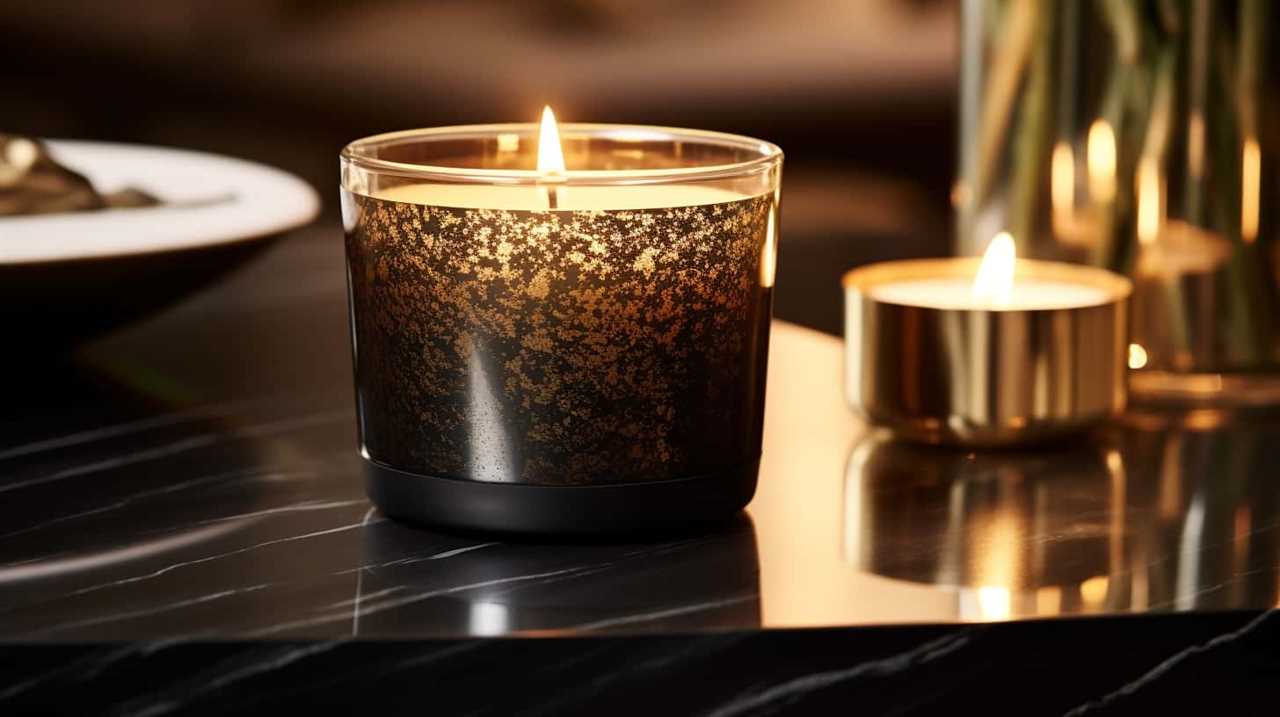Are you interested in learning how to prevent candle flickering? We’re here to uncover the secrets and assist you in mastering this skill.
Candle flickering can be quite distracting and can hinder the peaceful ambiance we seek. In this guide, we will explore the science behind this phenomenon and share practical tips on how to put an end to it.
By understanding the factors that contribute to flickering, selecting the right candles, trimming the wick, using candle snuffers, and avoiding drafts, you’ll be able to enjoy a flicker-free experience every time.
So, let’s dive in and discover the secrets to achieving a steady and serene candle burn.

Key Takeaways
- Choose a candle with a cotton wick and high-quality wax for steadier flames.
- Trim the wick regularly to control flame size and prevent flickering.
- Use a candle snuffer to extinguish candles without smoke or wax splatter.
- Avoid drafts and airflow by closing windows and doors, using candle shades or lanterns, and avoiding placement near air conditioning vents or fans.
Understanding the Science Behind Flickering
To understand the science behind candle flickering, we conducted experiments and observed the behavior of different candle types.
Candle flame behavior is influenced by several factors, including the role of oxygen in candle combustion. When a candle burns, it undergoes a process called combustion, where the heat from the flame vaporizes the wax. As the wax vapor rises, it reacts with oxygen in the air, producing carbon dioxide, water vapor, and heat.
The presence of oxygen is crucial for sustaining the flame, as it supports the chemical reactions needed for combustion. When the oxygen supply is limited, such as in a drafty area or when the candle is nearly extinguished, the flame becomes unstable and flickers.
Choosing the Right Type of Candle
When selecting the appropriate candle to prevent flickering, we should consider the type of wick, wax, and size. Here are some factors to keep in mind:
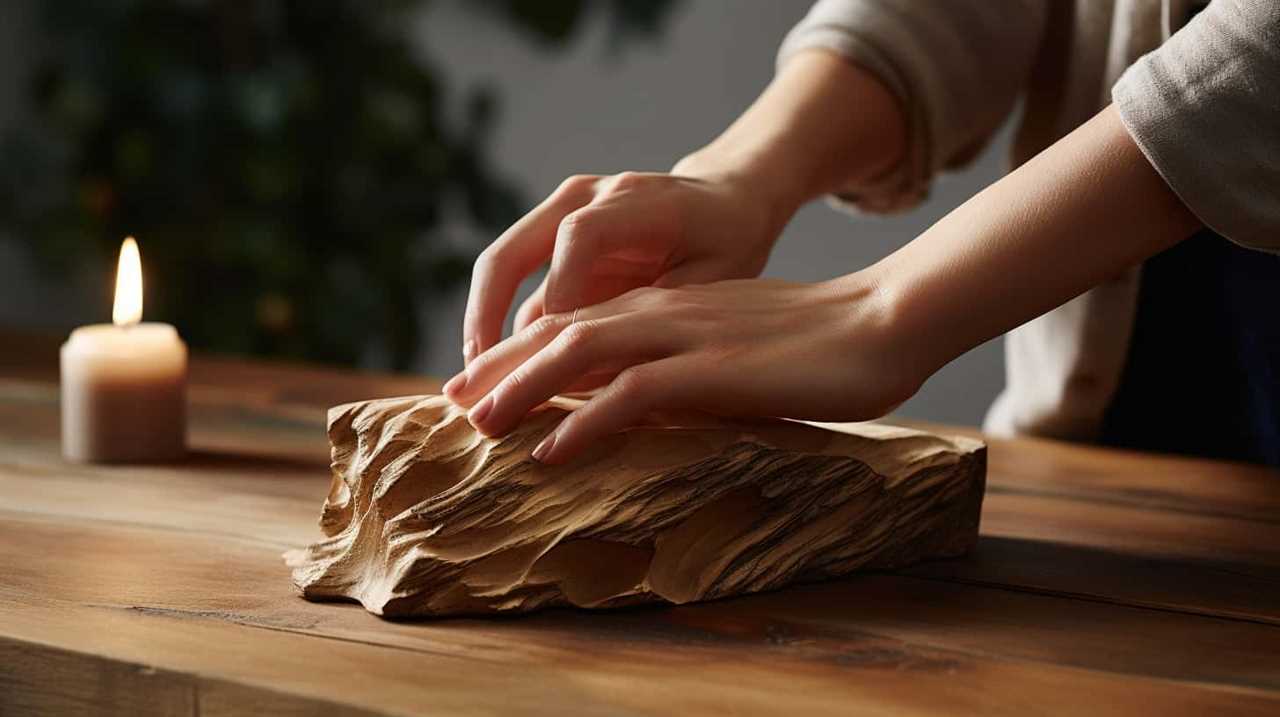
- Wick type: Opt for a cotton wick, as it burns more evenly and reduces the likelihood of flickering.
- Wax composition: Choose candles made from high-quality, non-toxic wax, such as soy or beeswax. These materials have a lower melting point and produce a steadier flame.
- Candle size: Larger candles tend to have more stable flames, so consider opting for candles with a wider diameter or taller height.
- Proper candle storage: Ensure that your candles are stored in a cool, dry place away from direct sunlight. Extreme temperatures and humidity can affect the candle’s stability and cause flickering.
By paying attention to these factors, you can select candles that are less prone to flickering, creating a more enjoyable and serene ambiance.
Additionally, remember to consider candle scent selection and proper candle storage to further enhance your candle’s performance.
Trimming the Wick for a Steady Burn
To ensure a steady burn and minimize flickering, we should regularly trim the wick of our candles. Wick maintenance is an essential practice for both achieving optimal performance and ensuring fire safety. Trimming the wick helps control the size of the flame, preventing it from becoming too large and causing the candle to flicker or produce excess smoke. It also helps to maintain an even burn and prolong the life of the candle. When trimming the wick, it is recommended to leave it at around ¼ inch in length for most candles. This can be done using a wick trimmer or simply by gently pinching off the excess wick with your fingers. By incorporating regular wick maintenance into our candle care routine, we can enjoy a consistent, steady burn while prioritizing fire safety.
| Benefits of Wick Maintenance | Proper Wick Length | Tools for Trimming |
|---|---|---|
| Minimizes flickering and smoke | Approx. 1/4 inch | Wick trimmer |
| Promotes even burn | Fingers | |
| Extends candle’s lifespan |
Using Candle Snuffers to Prevent Flickering
To prevent flickering, we can incorporate the use of candle snuffers into our candle care routine. Candle snuffers are effective tools that help extinguish candles without causing any smoke or wax splatter.
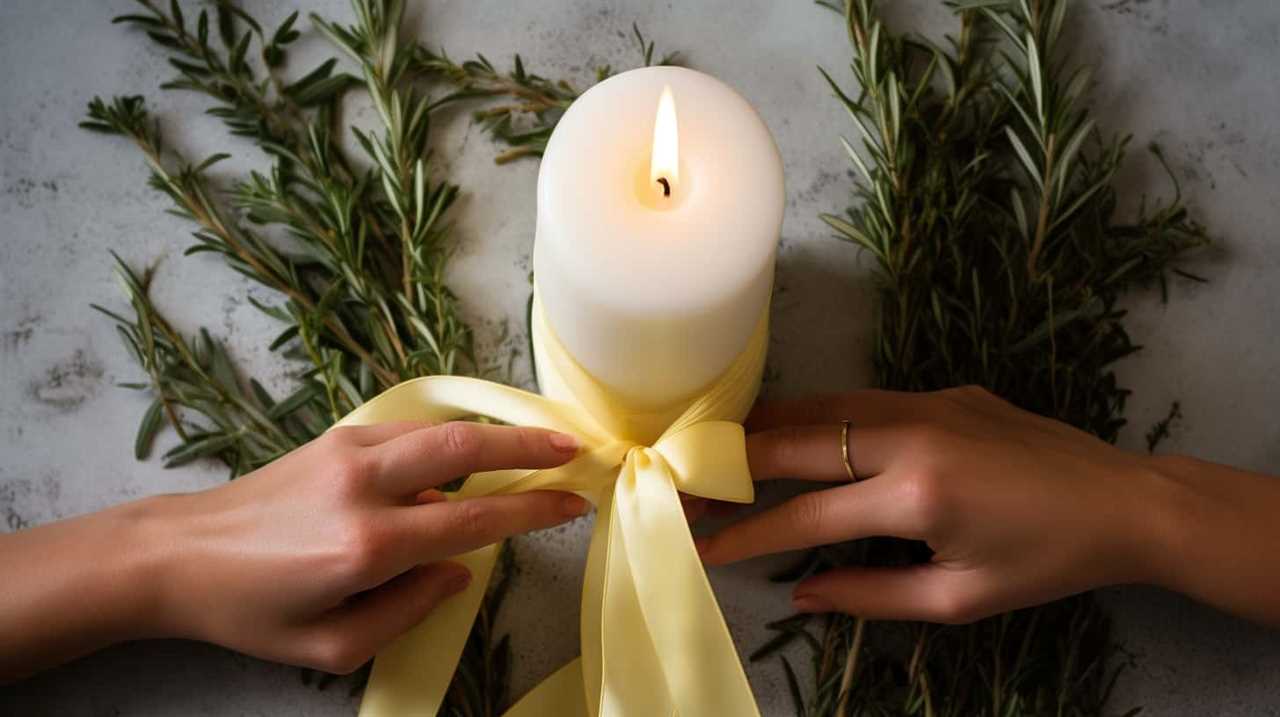
Here are four ways to use candle snuffers effectively:
- Approach the lit candle with the snuffer in a slow and gentle manner.
- Place the snuffer over the flame, covering it completely.
- Allow a few seconds for the snuffer to suffocate the flame.
- Lift the snuffer slowly to avoid any residual smoke or heat.
Using candle snuffers is a reliable and safe method to prevent flickering and prolong the life of your candles. However, if you don’t have a snuffer on hand, there are alternative methods to achieve the same goal.
Avoiding Drafts and Airflow Around Your Candles
To prevent candle flickering, it’s crucial to avoid drafts and airflow around your candles. We can employ various draft prevention techniques, such as closing windows and doors or using draft stoppers.
Additionally, carefully considering candle placement can help minimize the effects of air movement.

Draft Prevention Techniques
One of the most effective ways to prevent candle flickering is by eliminating any drafts or airflow around the candles. Here are four draft prevention techniques to keep in mind:
- Use draft stoppers: Placing draft stoppers around doors and windows can help minimize the amount of outside air that enters the room and disturbs the flame of your candles.
- Opt for sturdy candle holders: Choosing candle holders that are stable and sturdy can prevent the candles from being easily affected by slight movements or breezes in the room.
- Close windows and doors: Make sure to close any windows or doors in the vicinity of your candles to minimize the chances of a draft disturbing the flame.
- Avoid placing candles near vents or fans: Position your candles away from any vents or fans that could create a draft and cause the flame to flicker.
By implementing these draft prevention techniques, you can ensure a steady and tranquil flame for your candles.
Now, let’s move on to the next section about candle placement tips.
Candle Placement Tips
Now let’s explore some useful tips for placing your candles to prevent drafts and airflow from affecting their flames. Proper candle placement is crucial for ensuring candle safety and preventing flickering. To avoid drafts, place your candles away from open windows, doors, and air vents. It’s also important to keep candles away from fans or areas with high foot traffic.

To further protect your candles from airflow, consider using candle accessories such as candle shades or hurricanes, which can create a barrier around the flame. These accessories not only add a decorative touch but also help to maintain a steady flame.
By taking these precautions and using the right candle accessories, you can enjoy the calming ambiance of candles while ensuring their stability and safety.
Now, let’s explore the importance of stillness in preventing candle flickering.
Importance of Stillness
Let’s keep our candles steady and flicker-free by ensuring there are no drafts or airflow around them. Stillness is crucial for maintaining the calm and serene ambiance that candles create.
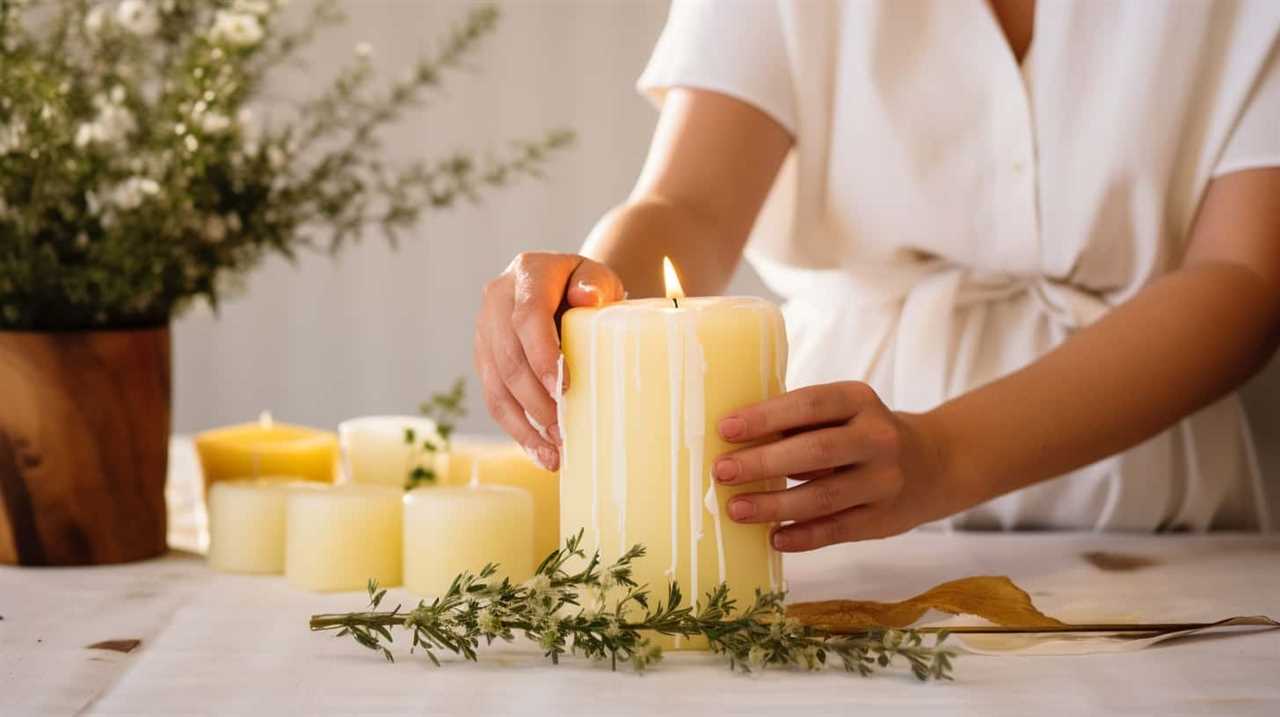
Here are four essential tips to help you achieve a draft-free environment for your candles:
- Mindfulness: Be mindful of the surroundings where you place your candles. Avoid areas with high traffic or open windows that may create drafts.
- Seal the gaps: Check for any gaps or cracks in the windows and doors near your candles. Use weatherstripping or caulk to seal them and prevent drafts from entering the room.
- Position strategically: Place your candles away from air vents, fans, or any sources of airflow. Opt for a stable surface where they’re less likely to be disturbed.
- Meditation techniques: Practice meditation techniques that promote stillness and tranquility in the room. Deep breathing exercises and focusing on the present moment can help create a calm environment for your candles.
Additional Tips and Tricks for a Flicker-Free Experience
To achieve a flicker-free experience, we recommend using high-quality candles made from beeswax or soy wax. However, if you’re still experiencing flickering issues, there are a few additional tips and tricks you can try.
One option is to prevent flickering with accessories. For example, you can use a candle snuffer to extinguish the flame instead of blowing it out, as this can help maintain a steady burn.
Another option is to troubleshoot flickering issues by trimming the wick. A long wick can cause uneven burning and flickering, so make sure to trim it to a quarter of an inch before lighting the candle.

Additionally, placing the candle in a draft-free area can also help prevent flickering.
Frequently Asked Questions
Can Using Scented Candles Increase the Likelihood of Flickering?
Using scented candles may increase the likelihood of flickering due to the effect of candle wick length on flickering behavior. Additionally, the impact of candle placement on flickering intensity can also contribute to this issue.
How Can I Prevent My Candles From Producing Excessive Smoke?
To prevent excessive smoke from candles, we need to focus on preventing candle soot and choosing the right wick. By taking these steps, we can enjoy a clean and smoke-free candle experience.
Is It Safe to Leave a Candle Unattended While It’s Burning?
Leaving a candle unattended while it’s burning is not safe. It can pose fire hazards and lead to accidents. It’s important to practice candle safety and never leave them unsupervised.
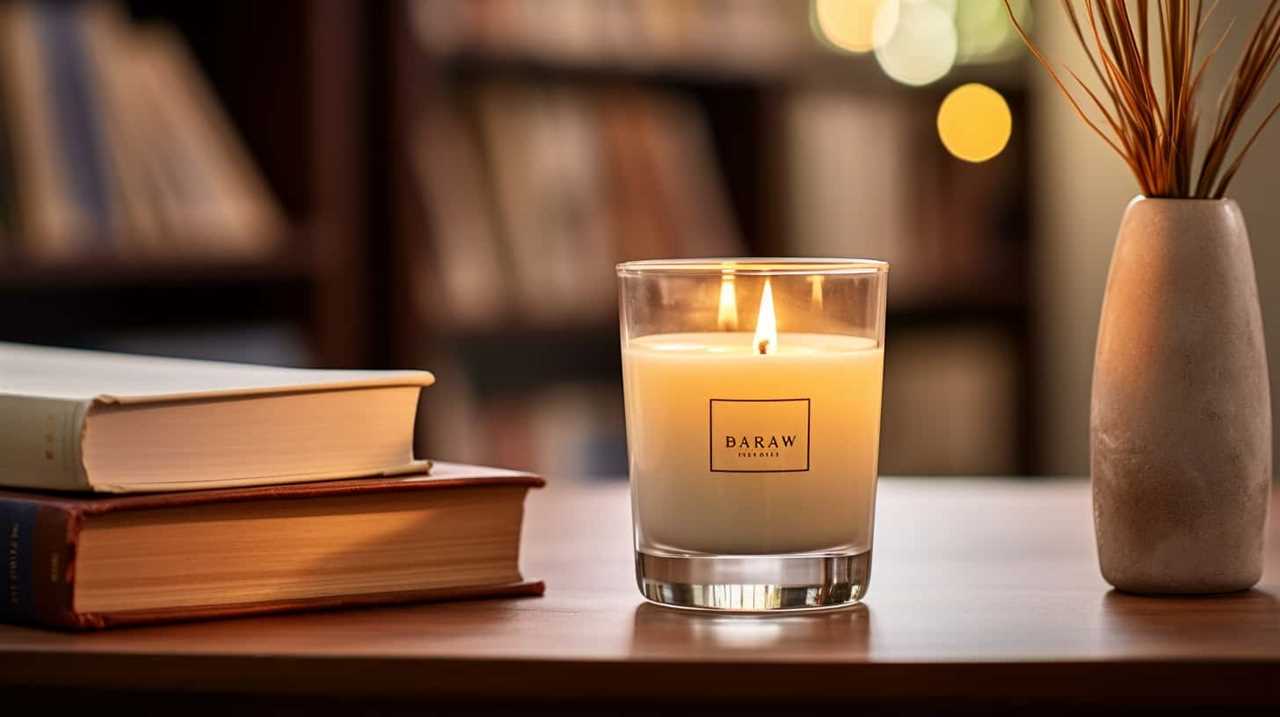
Can the Color of the Candle Affect Its Flickering Behavior?
The color of a candle can indeed impact its flickering behavior. Additionally, the shape of the candle can also affect the way it flickers. These factors contribute to the overall ambiance and experience of candlelight.
What Should I Do if My Candle Continues to Flicker Even After Following All the Recommended Steps?
If the candle continues to flicker despite following all the recommended steps, there are alternative solutions and troubleshooting tips you can try. Keep experimenting with different techniques until you find what works best for your candle.
Conclusion
In conclusion, understanding the science behind candle flickering and taking the necessary steps can help you achieve a steady burn. By choosing the right type of candle, trimming the wick, using candle snuffers, and avoiding drafts and airflow, you can enjoy a flicker-free experience.
For example, Sarah noticed that her candles always flickered when she placed them near an open window. After moving them to a different spot, she was able to enjoy a calm and steady flame.
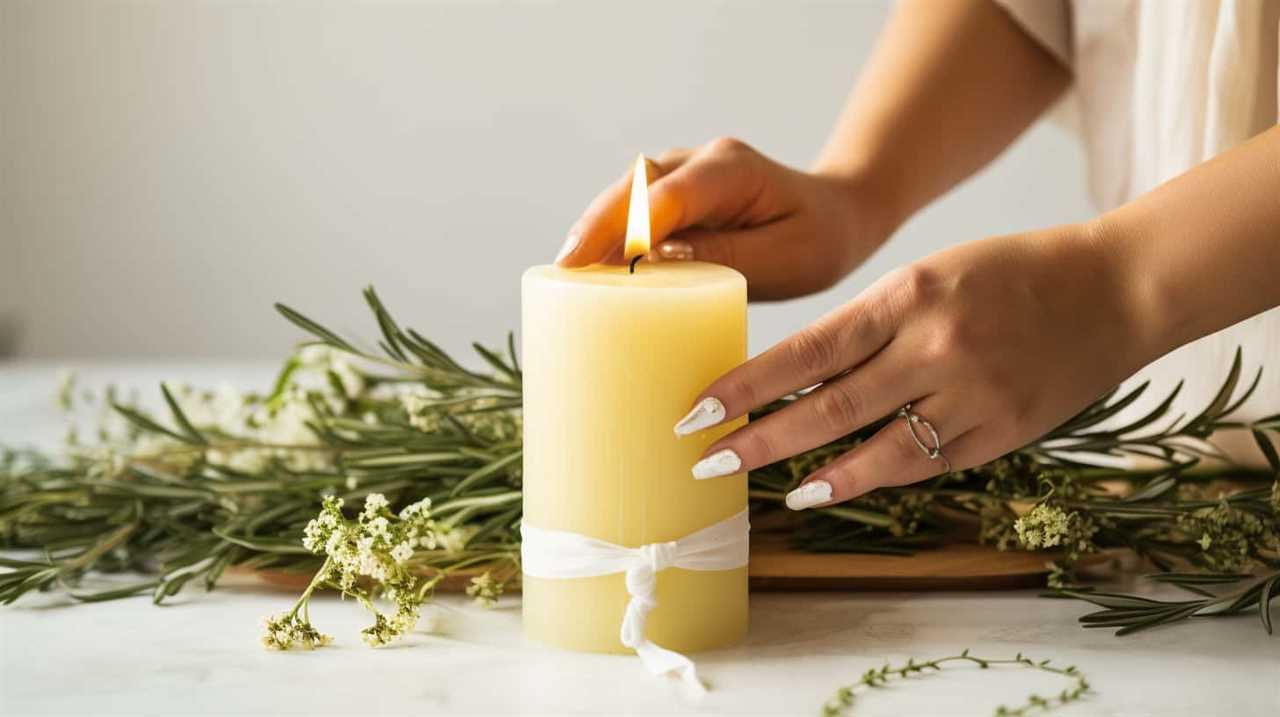
Remember, a little attention to detail goes a long way in preventing candle flickering.



